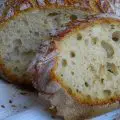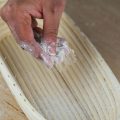Have you ever come across a sourdough recipe, where the baking process mentions an autolyse? The autolyse is a vital step in any bread baking routine, especially when you’re hoping to achieve a delicious, and moist textured loaf. Here’s a simple guide to help!
![Autolyse Bread: Mixing Flour The Right Way [Simple Guide] 42 Autolyse bread: mixing flour the right way [simple guide]](https://www.mydailysourdoughbread.com/wp-content/uploads/2022/09/CD-blog-images-2022-09-28T223141.887-1024x576.jpg)
Table of Contents
- What is Autolysis?
- How Does Autolyse Work?
- Can You Add Yeast to the Autolyse?
- Benefits of Autolysing
- How Long to Autolyse Bread?
- How to Autolyse Sourdough
- Why Add Sourdough Starter to an Autolyse?
- Types of Autolyse
- What Happens if You Autolyse too Long?
- Can You Autolyse Pizza Dough?
- So Why Autolyse?
- Autolyse Bread – FAQs
![Autolyse Bread: Mixing Flour The Right Way [Simple Guide] 43 Autolyse bread: mixing flour the right way [simple guide]](https://www.mydailysourdoughbread.com/wp-content/uploads/2022/09/blog-images-2023-02-10T215753.086-768x432.jpg)
How to Autolyse Sourdough
Ingredients
Ingredients
- 400g bread flour
- 280g water
Equipment
- stand mixer
Instructions
- Take a large bowl, add flour, and water, then use the back of a wooden ladle, or your hands to combine the flour and water.
- If you’re using a stand mixer, then knead at low speed for 3 minutes to thoroughly incorporate the ingredients.
- Cover the dough tightly, and let this autolyze for 45 minutes.
What is Autolysis?
Autolysis is the process of mixing flour and water in a recipe, followed by a 30-60 minute resting period.
After the dough has finished resting, the remaining ingredients are added and then the dough is kneaded.
This half-hour pause enables some significant changes to occur in the bread dough, resulting in a phenomenal improvement in your bread baking.
How Does Autolyse Work?
Autolyse is a versatile process that can be used in the processes of many bakery products including French bread, white pan bread, whole wheat bread, sourdough bread, and more.
During autolyse, your dough will develop:
- Stretchy gluten
- Repair broken protein
Stretchy Gluten
As the water is soaked up by the whole wheat flour, the protein present in the flour become instantly hydrated, enabling the gluten to soften, and unravel into longer gluten strands.
The damp flour will then experience an enzymic activity.
Repair Broken Protein
The process of gently activating a fully hydrated flour helps to repair any damaged gluten strands, which is a common occurrence in flour.
Flour that contains less protein can be strengthened during the autolyse, in preparation for bread baking.
![Autolyse Bread: Mixing Flour The Right Way [Simple Guide] 44 Autolyse bread: mixing flour the right way [simple guide]](https://www.mydailysourdoughbread.com/wp-content/uploads/2022/09/CD-blog-images-2022-09-28T223215.229-1024x576.jpg)
Can You Add Yeast to the Autolyse?
Adding yeast to the autolyse begins the respiration and alcoholic fermentation process to produce gas. The yeast consumes the sugars and starches in the dough, which may jeopardize the autolyse process.
This can lead to a dense loaf of bread, so it’s best to include yeast when it’s time to knead.
Benefits of Autolysing
As the gluten matures during autolyse, the result is significant enough to reduce the kneading time. Therefore, improving the taste, and structure of long fermented bread like sourdough.
The benefits of autolysing include:
- Reduced kneading effort
- Bran softening
- Improved gluten structure
- Better oven spring
- Easier scoring
Reduced Kneading Effort
Autolyse is especially effective when working with high-protein flours, resulting in reduced kneading efforts.
When working on recipes that require flours that absorb too much water like semolina or durum, the kneading process can be a tedious task.
Which is why a longer resting period or autolyse, leads to a shorter kneading time, with minimum effort.
Bran Softening
When the bran or fiber meet water, they become softer and easier to work with. Autolyse allows the flour to absorb enough water to make this necessary.
Improved Gluten Structure
The final dough will have an improved and stable gluten structure.
While kneading can sort of force a gluten formation, gluten strengthening and gluten tearing occur during this process of vigorously working the dough.
On the other hand, gluten development happens at its own pace during autolyse, without breaking or tearing the gluten strands.
Therefore producing a brilliant dough structure, with an open and airy crumb.
Better Oven Spring
A stronger gluten structure enables a fantastic oven spring and open crumb, compared to an underdeveloped and over-kneaded dough.
Easier Scoring
Scoring sourdough bread is an important step in sourdough bread baking. Once your dough has undergone autolysis, it will be easier and smoother to hold and shape, meaning scoring your dough will be quick and easy, resulting in the perfect crust.
![Autolyse Bread: Mixing Flour The Right Way [Simple Guide] 45 Autolyse bread: mixing flour the right way [simple guide]](https://www.mydailysourdoughbread.com/wp-content/uploads/2022/09/CD-blog-images-2022-09-28T223240.436-1024x576.jpg)
How Long to Autolyse Bread?
A dough’s rest time will depend upon its protein and fiber content, meaning that the duration of autolyse can vary depending on the type of flour. Normally, a prolonged autolyse would require a low temperature environment to control the enzymatic activities.
Here is an example of this:
| Type of Flour | Autolyse Duration |
| All purpose flour | 30 minutes to 1 hour |
| Whole wheat flour | 45 minutes to 4 hours |
| Bread flour | 30 minutes to 2 hours |
| Semolina flour | 1 to 5 hours |
![Autolyse Bread: Mixing Flour The Right Way [Simple Guide] 46 Bread dough](https://www.mydailysourdoughbread.com/wp-content/uploads/2022/09/sourdough-bread-stockpack-unsplash-scaled.jpg)
How to Autolyse Sourdough
Add the flour and water to a large bowl and mix till well combined.
For lower hydration doughs, it is better to mix the ingredients until you achieve a shaggy consistency. A wetter dough requires a thoroughly incorporated dough, minus the kneading.
Cover the bowl and let the dough rest or autolyse for 10 minutes, add your sourdough starter and salt to the mix, before proceeding with the rest of the recipe.
Materials
- Stand mixer
- 400g bread flour
- 280g water
Instructions
- Take a large bowl, add flour, and water, then use the back of a wooden ladle, or your hands to combine the flour and water.
- If you’re using a stand mixer, then knead at low speed for 3 minutes to thoroughly incorporate the ingredients.
- Cover the dough tightly, and let this autolyse for 45 minutes.
Why Add Sourdough Starter to an Autolyse?
When baking sourdough bread, the sourdough starter can tighten the gluten strands, which is why an autolyse should be done before the starter is added to the dough.
Although more sourdough recipes require a certain level of hydration in order for the flour to fully hydrate and the enzymes to activate.
This would mean adding the salt and sourdough starter with the flour and the water, because without there, there won’t be enough water in the dough to autolyze.
![Autolyse Bread: Mixing Flour The Right Way [Simple Guide] 47 Autolyse bread: mixing flour the right way [simple guide]](https://www.mydailysourdoughbread.com/wp-content/uploads/2022/09/CD-blog-images-2022-09-28T224522.449-1024x576.jpg)
Types of Autolyse
In true autolyse, the process involves a combination of flour and water, followed by the appropriate resting time, before kneading and baking. This method is most common in sourdough baking.
In modified autolyse there are more elements involved in the process. This could be salt, yeast, or a yeast mixture.
There are two kinds of modified autolyse:
- Saltolyse
- Fermentolyse
Saltolyse
Saltolyse is defined through the process of combining salt, flour and water, then setting this mixture aside to rest for a certain period of time.
The salt helps tighten the gluten structure, effectively reducing the enzymatic activities. In some recipes a prolonged fermentation process is required, so the inclusion of salt can help reduce the activity during autolyse.
Fermentolyse
This type of autolyse involves a fermentation process, so in this method, yeast will need to be added to the flour and water mixture. The yeast must be activated in warm water or milk with sugar before it is added to the dough. This liquid yeast mixture cannot be added to the dough after autolyse.
Therefore, it’s best to add active dry yeast to the flour and water combination before autolyse.
What Happens if You Autolyse too Long?
The dough can become very weak when it rests for longer than necessary. This is why prolonged 3-4 hour dough rests should be done in the fridge, as the cold temperature will ensure the yeast activity remains activated.
Can You Autolyse Pizza Dough?
Most pizza bakers choose to autolyse their pizza dough for 45 minutes to an hour before kneading. This process assures a wonderful texture, and pleasant flavored pizza.
So Why Autolyse?
Autolyse is the key step in bread making, to ensure a delicious outcome.
If you’re looking for the perfect moist loaf, with an open and airy crumb, then autolyse is the way to go!
Autolyse Bread – FAQs
What Does Autolyse do to Bread Dough?
Autolyse hydrates the flour in the bread dough, encouraging the gluten development.
Should You Autolyse Bread?
You should autolyse your bread for 15-30 minutes, as this makes your dough easier to handle.
How do You Autolyse Bread?
The process of autolysing involves gently mixing flour and water in a bread recipe, followed by a 30-60 minute resting period.
What is the Benefit of Autolyse?
The main benefits of autolysing your dough is that your final loaf will have a pleasant appearance, taste, texture, and extended shelf life.





![What You Need To Know About Coil Fold Sourdough [Doing It Right!] 52 What you need to know about coil fold sourdough [doing it right! ]](https://www.mydailysourdoughbread.com/wp-content/uploads/2023/01/blog-images-27-120x120.jpg)
